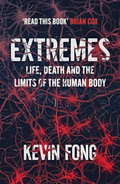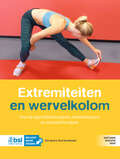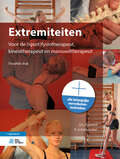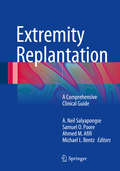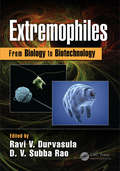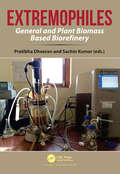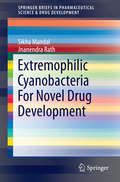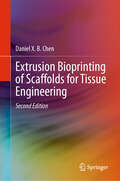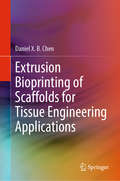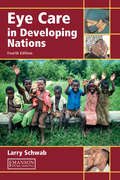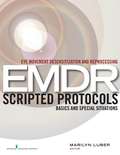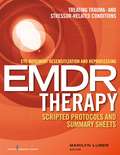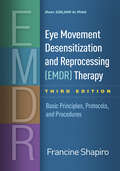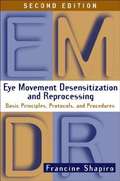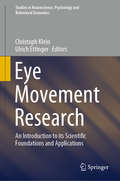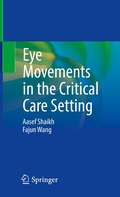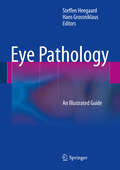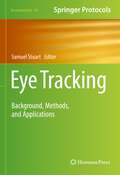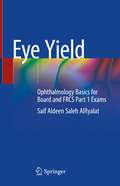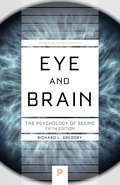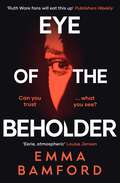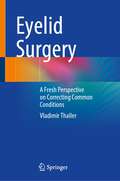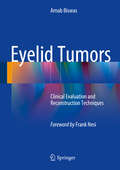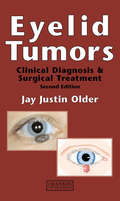- Table View
- List View
Extremes: Life, Death and the Limits of the Human Body
by Kevin FongIn anaesthetist Dr Kevin Fong's television programmes he has often demonstrated the impact of extremes on the human body by using his own body as a 'guinea pig'. So Dr Fong is well placed to share his experience of the sheer audacity of medical practice at extreme physiological limits, where human life is balanced on a knife edge. Through gripping accounts of extraordinary events and pioneering medicine, Dr Fong explores how our body responds when tested by the extremes of heat and cold, vacuum and altitude, age and disease. He shows how science, technology and medicine have taken what was once lethal in the world and made it survivable. This is not only a book about medicine, but also about exploration in its broadest sense - and about how, by probing the very limits of our biology, we may ultimately return with a better appreciation of how our bodies work, of what life is, and what it means to be human.
Extremiteiten en wervelkolom: Voor de (sport)fysiotherapeut, kinesitherapeut en manueel therapeut
by Dick Egmond Ruud SchuitemakerVoor u ligt de volledig herziene 13de druk van Extremiteiten en wervelkolom, het standaardwerk voor de onderzoeks- en behandeltechnieken van alle musculoskeletale lichaamsregio&’s, inclusief de bekkenregio en het kaakgewricht. Met voor het eerst een totaaloverzicht van het curriculum van de (sport)fysiotherapeut, kinesitherapeut en manueel therapeut. Wat is nieuw in deze 13de druk? 60 Nieuwe video&’s Er zijn nu 591 demonstratievideo&’s van 431 technieken en 160 oefeningen. Alle video&’s zijn nu ondertiteld in het Nederlands, Engels en Duits Binnen de video&’s kan eenvoudig worden genavigeerd. 114 Flashtrains Elk cluster van technieken beschikt over een &‘flashtrain&’. Een flash is een korte versie van een demonstratievideo met de essentie van de techniek of oefening. Nieuwe illustraties en foto&’s Alle bestaande figuren zijn sterk verbeterd. • Spiegeltherapie Het blijkt niet alleen effectief bij amputatiepatiënten maar ook bij chronische-pijnpatiënten (demonstratievideo&’s met echte patiënten!). • Neurodynamica Binnen het &‘concept van de bindweefselplaten&’ (&‘New Anatomy&’) en in de functionele oefeningen krijgt dit meer aandacht en onderbouwing. • Vestibulaire duizeligheid met de &‘bevrijdingsmanoeuvres bij BPPD&’ Dit heeft een prominente plek gekregen in de flink uitgebreide paragraaf over duizeligheid van hoofdstuk 12. • De algemene hoofdstukken 1 t/m 6 zijn geactualiseerd Ze bevatten de nodige achtergrondinformatie voor het klinisch redeneerproces en de correcte toepassing van de technieken. • De speciële hoofdstukken 7 t/m 17 zijn uitgebreid Ze bevatten nu alle onderzoeks- en behandeltechnieken, een patronenmatrix en een eigen huiswerkoefeningenprotocol. • Hoofdstuk 18 (oefentherapie) is uitgebreid met 43 nieuwe oefeningen. • E-health Door de samenwerking met diverse apps/platforms voor fysiotherapeuten kunnen de oefeningenvideo&’s uit hoofdstuk 18 vanuit het Fysio-EPD naar patiënten worden verstuurd. • Nieuwe EXTRA&’s online Met osteo- en artrokinematica, infographics, richtlijnen en wetenschappelijke studies. Dick Egmond is fysiotherapeut, manueel therapeut (Wolfsburg, Dld) en oprichter/docent Institut für Angewandte Manuelle Therapie (IFAMT GmbH). Ruud Schuitemaker is fysiotherapeut, manueel therapeut (Amsterdam), schouderspecialist en docent na- en bijscholing voor fysio- en manueel therapeuten.
Extremiteiten: Voor de (sport)fysiotherapeut, kinesitherapeut en manueeltherapeut
by R. Schuitemaker D.L. EgmondDit boek is sinds 1978 hét standaardwerk voor de fysiotherapie en manuele therapie in Nederland voor wat betreft onderzoek- en behandeltechnieken, tests en oefeningen. Een veel gebruikt naslagwerk tijdens de opleiding van bachelor- en masterstudenten en op de werkvloer van de algemeen fysiotherapeut, kinesitherapeut, sportfysiotherapeut en manueeltherapeut.Wat is nieuw? Deze twaalfde druk bevat maar liefst vijf nieuwe hoofdstukken. Naast de nieuwste onderzoek- en behandelvaardigheden van de extremiteiten, worden nu ook alle belangrijke (HVT-) technieken van de TOTALE wervelkolom, het bekken- en de kaakregio beschreven en op video gedemonstreerd. Alle richtlijnen t/m 2018 zijn verwerkt zodat het boek bijzonder geschikt is om als naslagwerk te worden gebruikt bij het klinisch redeneren. Het hoofdstuk ‘Functionele oefeningen’ (H18) is sterk uitgebreid met maar liefst 48 nieuwe oefeningen. Per hoofdstuk is een verklarende woordenlijst opgenomen. Daarnaast zijn nu kant-en-klare (ook BIBO-) onderzoek- en behandelprotocollen toegevoegd.Hoofdstuk 1 t/m 6 – Dit is het algemene deel dat de benodigde achtergrondinformatie levert voor het speciële deel, het klinisch redeneerproces en de dossiervoering. Hoofdstuk 7 t/m 18 – Dit is het speciële deel waarin de technieken, tests en oefeningen worden beschreven van de gehele bovenste en onderste lichaamshelft. Nu inclusief de wervelkolom, bekken- en kaakregio.Extremiteiten is het handboek voor schouderspecialisten. De auteurs zijn vele jaren actief voor schoudernetwerken in Nederland en Duitsland en hebben hun kennis en vaardigheden over de schouderregio vooral neergelegd in H9, de schouderregio, H10 de thoracale wervelkolom en ribben, en H11 de cervicale wervelkom. Wat staat online? Deze twaalfde druk van Extremiteiten is een forse uitbreiding en grondige herziening van de elfde druk uit 2014. Het geheel is ook online beschikbaar. Als vanouds levert het een belangrijke bijdrage aan de wetenschappelijke onderbouwing van de fysiotherapie en manuele therapie door duidelijke videodemonstraties van alle in het boek beschreven technieken, tests en oefeningen. Meer dan 500 instructievideo’s kunnen via één muisklik worden bekeken op de bijbehorende website met inlogcode. Daar zijn ook andere digitale extra’s te vinden, zoals uitgebreide achtergrondinformatie en biomechanica. Dick Egmond en Ruud Schuitemaker zijn de auteurs van Extremiteiten. Dick Egmond (1961) is fysiotherapeut en manueeltherapeut in Wolfsburg (Dld), docent manuele therapie en schoolleider van het Institut für Angewandte Manuelle Therapie Duitsland (www.ifamt.de). Hij is oprichter en voorzitter van Schulternetzwerk Deutschland (www.schulternetzwerk.de) en lid van het Scientific Committee van EUSSER (Europees Schoudernetwerk). Ruud Schuitemaker (1955) is fysiotherapeut en manueeltherapeut bij Schuitemaker en Van Schaik te Amsterdam (www.fysio.net), docent manuele therapie en docent na- en bijscholing voor fysio- en manueeltherapeuten in Nederland, België en Duitsland. Hij was medeauteur van de SNN Praktijkrichtlijn Frozen Shoulder 2017.
Extremity Replantation
by A. Neil Salyapongse Samuel O. Poore Ahmed M. Afifi Michael L. BentzExtremity Replantation is a comprehensive text covering all aspects of the upper and lower limb, with an emphasis on state-of-the-art techniques in the surgical and medical management of amputation and avulsion injuries as well as the current understanding of the recovery of function following replantation. It is organized following anatomical zones - thumb, digits, wrist, forearm and elbow; foot, ankle and lower leg - with special chapters dedicated to issues common to all replants, such as complications, medical management, nerve recovery and rehabilitation. Furthermore, the international team of authors demonstrates approaches from the entire spectrum of replantation care specialists, including plastic and reconstructive surgeons, orthopedists, and hand therapists. Generously illustrated with intra-operative photos, this book will serve as a standard reference for orthopedic, reconstructive, plastic, and hand surgeons as well as physicians or ancillary medical staff caring for the replant patient.
Extremophiles: From Biology to Biotechnology
by Ravi V. Durvasula D. V. Subba RaoHighly recommended by CHOICE, Oct 2018 Key features: Couples studies of marine extremophile biology/genomics and extremophile culture for biotechnological applications with the latest advances in bio-prospecting and bio-product development Includes practical experiments that a laboratory can use to replicate extreme habitats for research purposes Presents latest advances in extremophile genomics to give the reader a better understanding of the regulatory mechanisms of extremophiles Offers insights into the production of commercially important extremozymes, carotenoids, bioactive compounds and secondary metabolites of medicinal value Extremophiles are nature’s ultimate survivors, thriving in environments ranging from the frozen Antarctic to abyssal hot hydrothermal vents. Their lifeforms span bacteria to fishes, and are categorized as halophiles from hypersaline environments, acidophiles from acidic waters, psychrophiles from cold habitats, and thermophiles from warm waters. Extremophiles: From Biology to Biotechnology comprehensively covers the basic biology, physiology, habitats, secondary metabolites for bioprospecting, and biotechnology of these extreme survivors. The chapters focus on the novel genetic and biochemical traits that lend these organisms to biotechnological applications. This unique guide serves as a resource for biotechnologists who wish to explore extremophiles for their commercial potential, as well as a valuable reference for teaching undergraduate, graduate and postgraduate students.
Extremophiles: General and Plant Biomass Based Biorefinery
by Pratibha DheeranThis book, Extremophiles: General and Plant Biomass Based Biorefinery, explores the potential of extremophiles in industries and biomass based biorefinery. The book sheds light on diversity and various applications of thermophiles, psychrophiles, halophiles, alkaliphiles and acidophiles for the production of value-added products including biofuels, extremozymes, etc. The chapters comprehensively emphasize the utility of extremophiles in sustainable biorefinery bioprocesses. This book is an integrated source of literature for scientists, engineers, academicians, and students working in the area of extremophiles, microbial technology and biorefinery.
Extremophilic Cyanobacteria For Novel Drug Development
by Sikha Mandal Jnanendra RathThis volume presents recent developments in the novel drug development and potential of extremophilic cyanobacteria. It discusses how these tiny organism originated, produce oxygen that leads to evolution of life on the earth, how their survival strategies in extreme climatic conditions lead to diverse metabolic pathways, and the opportunity to use them to develop novel drugs. The book is comprised of five chapters, starting with the origin of cyanobacteria, their survival strategies under extreme conditions, and their capabilities to change metabolic activities. The second chapter explores the different metabolic pathways found in cyanobacteria and examines advances in this field and recent techniques like MALDI-TOF imaging and metagenomics tools as well as in silico techniques for rapid screening of secondary metabolites. Further chapters cover the glycomics of cyanobacteria, anticancer drug development, and some issues and challenges of using cyanobacteria to develop drugs. Extremophilic Cyanobacteria For Novel Drug Development provides insight into future perspectives in drug development and is a key resource for students, researchers and professionals in pharmacy, medicinal chemistry, pharmacognosy biotechnology, biology, and academics.
Extrusion Bioprinting of Scaffolds for Tissue Engineering
by Daniel X. ChenThis book introduces readers to the theory and practice of extrusion bioprinting of scaffolds for tissue engineering and modeling. The text emphasizes the fundamentals and practical applications of extrusion bioprinting for scaffold fabrication, in a manner particularly suitable for those (including both undergraduate and graduate students) who wish to master the subject matter and apply it to real tissue engineering. Readers will learn how to design, fabricate, and characterize tissue scaffolds to be created by extrusion bioprinting technologies. This book: Covers tissue engineering and various scaffold fabrication techniques Presents the general requirements imposed on scaffolds and the scaffold design process Discusses the preparation and characterization of biomaterials and bioink for extrusion bioprinting Educates readers regarding how to bioprint and characterize scaffolds with living cells for tissue engineering and modeling Introduces the common methods/ techniques used to measure and characterize the mechanical properties of native tissues and scaffolds Discusses various approaches to create vascular networks within tissue scaffolds to facilitate their functions Introduces the concept of controlled release and the common strategies for regulating biomolecules in tissue engineering and printed scaffolds Includes many case studies of bioprinting and characterizing scaffolds for tissue engineering and modeling, to reflect the recent advances in the field of bioprinting
Extrusion Bioprinting of Scaffolds for Tissue Engineering Applications
by Daniel X. ChenThis book introduces readers to the theory and practice of extrusion bio-printing of scaffolds for tissue engineering applications. The author emphasizes the fundamentals and practical applications of extrusion bio-printing to scaffold fabrication, in a manner particularly suitable for those who wish to master the subject matter and apply it to real tissue engineering applications. Readers will learn to design, fabricate, and characterize tissue scaffolds to be created by means of extrusion bio-printing technology.
Eye Care in Developing Nations
by Larry SchwabThe number of the millions of blind in the world continues to grow, causing needless social and economic deprivation. Most of these blind can be cured, and much of the remainder prevented if all people had access to the simple and effective interventions that already exist. In this newly revised fourth edition ofEye Care in Developing Nations', t
Eye Movement Desensitization and Reprocessing (EMDR) Scripted Protocols: Basics and Special Situations
by Marilyn LuberThis excellent book contains many different scripts, applicable to a number of special populations. It takes a practical approach and walks therapists step-by-step through the EMDR therapeutic process. This book serves as a one-stop resource where therapists can access a wide range of word-for-word scripted protocols for EMDR practice, including the past, present, and future templates. These scripts are conveniently outlined in an easy-to-use, manual style template for therapists, allowing them to have a reliable, consistent form and procedure when using EMDR with clients. The book contains an entire section on the development of resources and on clinician self-care. There is a self-awareness questionnaire to assist clinicians in identifying potential problems that often arise in treatment, allowing for strategies to deal with them. Also included are helpful past memory, current triggers and future template worksheet scripts. Key topics include: Client history taking that will inform the treatment process of patients Resource development to help clients identify and target their problems to regain control when issues appear overwhelming Scripts for the 6 basic EMDR Protocols for traumatic events, current anxieties and behaviors, recent traumatic events, phobias, excessive grief, and illness and somatic disorders Early intervention procedures for man-made and natural catastrophes EMDR and early interventions for groups, including work with children, adolescents, and adults Written workbook format for individual or group EMDR EMDR to enhance performance and positive emotion.
Eye Movement Desensitization and Reprocessing (EMDR) Therapy Scripted Protocols and Summary Sheets: Treating Trauma- and Stressor-Related Conditions
by Marilyn LuberThis book focuses on EMDR Therapy as a psychotherapy approach based on standard procedures and protocols for trauma and stressor-related conditions. Using EMDR Therapy’s standard procedures and protocols as its template, this book presents step-by-step scripts that enable new practitioners and seasoned EMDR clinicians, trainers, and consultants alike to incorporate EMDR Therapy into their case conceptualizations and treatment plans while working with patients who have issues related to trauma, and stressor-related conditions. These scripts can be put to use immediately and retain the complete integrity of EMDR Therapy by presenting the three-prong protocol (past memories, present triggers, and future templates) and the 11-step procedure essential to the standard practice of EMDR Therapy. The chapters are conveniently presented in an easy-to-use manual-style format that facilitates a reliable, consistent procedure. Scripts and summary sheets are available in an expandable, downloadable format for easy digital access for each protocol to simplify the gathering of information and to document it in clients’ charts in a consistent format. This facilitates quick retrieval of the essential issues and components needed by clinicians to create appropriate treatment plans.
Eye Movement Desensitization and Reprocessing (EMDR) Therapy, Third Edition: Basic Principles, Protocols, and Procedures
by Francine ShapiroThe authoritative presentation of Eye Movement Desensitization and Reprocessing (EMDR) therapy, this groundbreaking book--now revised and expanded--has enhanced the clinical repertoires of more than 100,000 readers and has been translated into 10 languages. Originally developed for treatment of posttraumatic stress disorder (PTSD), this evidence-based approach is now also used to treat adults and children with complex trauma, anxiety disorders, depression, addictive behavior problems, and other clinical problems. EMDR originator Francine Shapiro reviews the therapy's theoretical and empirical underpinnings, details the eight phases of treatment, and provides training materials and resources. Vivid vignettes, transcripts, and reproducible forms are included. Purchasers get access to a Web page where they can download and print the reproducible materials in a convenient 8 1/2" x 11" size. New to This Edition *Over 15 years of important advances in therapy and research, including findings from clinical and neurophysiological studies. *New and revised protocols and procedures. *Discusses additional applications, including the treatment of complex trauma, addictions, pain, depression, and moral injury, as well as post-disaster response. *Appendices with session transcripts, clinical aids, and tools for assessing treatment integrity and outcomes. EMDR therapy is recognized as a best practice for the treatment of PTSD by the U.S. Departments of Veterans Affairs and Defense, the International Society for Traumatic Stress Studies, the World Health Organization, the U.K. National Institute for Health and Care Excellence (NICE), the Australian National Health and Medical Research Council, the Association of the Scientific Medical Societies in Germany, and other health care associations/institutes around the world.
Eye Movement Desensitization and Reprocessing (EMDR), Second Edition
by Francine ShapiroThis volume provides the definitive guide to Eye Movement Desensitization and Reprocessing (EMDR), the psychotherapeutic approach developed by Francine Shapiro. EMDR is one of the most widely investigated treatments for posttraumatic stress disorder, and many other applications are also being explored. Presenting background on EMDR's development, theoretical constructs, and possible underlying mechanisms, the volume also contains detailed descriptions and transcripts that guide the clinician through every stage of therapeutic treatment, from client selection to the administration of EMDR and its integration within a comprehensive treatment plan. Among the many clinical populations for whom the material in this volume has been seen as applicable are survivors of sexual abuse, crime, and combat, as well as sufferers of phobias and other experientially based disorders. New to This Edition Updated neurobiological data, findings from controlled clinical studies, and literature on emerging clinical applications. Updated protocols and procedures for working with adults and children with a range of presenting problems. Special feature Two online-only appendices were added in 2009. These appendices comprehensively review current research on EMDR and its clinical applications.
Eye Movement Research: An Introduction to its Scientific Foundations and Applications (Studies in Neuroscience, Psychology and Behavioral Economics)
by Christoph Klein Ulrich EttingerThis edited volume presents fundamentals as well as applications of oculomotor methods in industrial and clinical settings. The topical spectrum covers 1.) basics and background material, 2.) methods such as recording techniques, markov models, Lévy flights, pupillometry and many more, as well as 3.) a broad range of applications in clinical and industrial settings. The target audience primarily comprises research experts and practitioners, but the book may also be beneficial for graduate students.
Eye Movements in the Critical Care Setting
by Aasef Shaikh Fajun WangThis book describes the abnormal eye movements encountered in the critical care unit in everyday practice and elaborates on the mechanism and clinical significance behind them. Beginning with a thorough grounding of the basic anatomy and physiology ocular motor system and how they move the eyeballs; chapters explore the pathological descriptions of all the signs that a practicing neurologist, ophthalmologist, or emergency medicine specialist might see in other ICU's, as well as the diagnostic and prognostic evidence to answer the consult questions. Further chapters describe the abnormal ocular movements seen in the Neuro-ICU, Eye Movements in the Critical Care Setting is a comprehensive resource on eye movement in the critical care setting, and a useful guide for the neurologist, ophthalmologist, and emergency medical specialist and residents alike.
Eye Pathology
by Steffen Heegaard Hans GrossniklausThis book is a comprehensive, in-depth, and up-to-date resource on eye pathology that will be of great practical value for ophthalmic and general pathologists and ophthalmologists. Congenital abnormalities, inflammatory conditions, infections, injuries, degenerative diseases, and tumors are all covered with the aid of more than 700 images. In the case of tumors, the wide variety of neoplasms that occur in the eyelid, conjunctiva, retina, uveal tract, lacrimal gland and sac, orbit, and optic nerve are comprehensively reviewed, and the most recent knowledge on the relation between genetics and prognosis is presented. Entries on specific diseases are organized in a standard way, with information on etiology, epidemiology, clinical presentation, pathological characteristics, differential diagnosis, therapy, and prognosis. The authors are all recognized experts and members of the European and American ophthalmic pathology societies.
Eye Tracking: Background, Methods, and Applications (Neuromethods #183)
by Samuel StuartThis volume explores the latest eye-tracking methodologies that help researchers understand the background, methods, and applications involved in these studies. The chapters in this book cover topics such as methods and models of eye-tracking in natural environments; natural gaze informatics (i.e., assisted wheelchair mobility); eye-tracking application to understand the visual control of locomotion; eye movement in neurological disorders; and eye movements in sports research and practice. In the Neuromethods series style, chapters include the kind of detail and key advice from the specialists needed to get successful results in your laboratory. Cutting-edge and practical, Eye Tracking: Background, Methods, and Applications is a valuable resource for experienced and novice researchers interested in learning more about this field and its future developments.
Eye Yield: Ophthalmology Basics for Board and FRCS Part 1 Exams
by Saif Aldeen AlRyalatThe book provides high yield information in basic ophthalmology including anatomy, physiology, pathology, pharmacology, microbiology, and embryology that are required for preparation of ophthalmology exams. The book focusses on all parts of the eye, with special focus on basic science including appropriate amount of information on clinical science for students and trainees. It is written in a lucid manner with textual notes and illustrations for quick learning and better understanding. Each section contains high yield information in separate points, with commonly asked information in “Eye Yield Note” boxes. It also includes estimated study time for each section to better plan the study. It also includes a pre-exam night study section at the end of the book that provides the information to be reviewed just before the exam. The book will be very helpful in passing almost all basic ophthalmology exams in a relatively short study time, by skipping the “filling” text available in most of the textbooks. It will be an excellent read for post graduate students looking for concise revision material. It will be relevant for medical students, ophthalmology residents, and medical doctors applying for ophthalmology residency and also for FRCS Part 1 exam.
Eye and Brain: The Psychology of Seeing
by Richard L. GregorySince the publication of the first edition in 1966, Eye and Brain has established itself worldwide as an essential introduction to the basic phenomena of visual perception. Richard Gregory offers clear explanations of how we see brightness, movement, color, and objects, and he explores the phenomena of visual illusions to establish principles about how perception normally works and why it sometimes fails. Illusion continues to be a major theme in the book, which provides a comprehensive classification system. There are also sections on what babies see and how they learn to see, on motion perception, the relationship between vision and consciousness, and on the impact of new brain imaging techniques. sentation of the text and illustrations has been improved by the larger format and new page design. The thousands of readers of the previous editions of Eye and Brain will find this new revised edition even more attractive and enthralling.
Eye and Brain: The Psychology of Seeing (Fifth edition)
by Richard L. GregorySince the publication of the first edition in 1966, Eye and Brain has established itself worldwide as an essential introduction to the basic phenomena of visual perception. In this book, Gregory offers clear explanations of how we see brightness, movement, color, and objects, and he explores the phenomena of visual illusions to establish principles about how perception normally works and why it sometimes fails. Although successive editions have incorporated new discoveries and ideas, this is the first time that Richard Gregory has completely revised and updated the text, adding more than thirty new illustrations. The phenomena of illusion continue to be a major theme in the book, in which the author makes a new attempt to provide a comprehensive classification system. There are also new sections on what babies see and how they learn to see, on motion perception, and tantalizing glimpses of the relationship between vision and consciousness and of the impact of new brain imaging techniques. In addition, the presentation of the text and illustrations has been improved by the larger format and new page design. The thousands of readers of the previous editions of Eye and Brain will find this new revised edition even more attractive and enthralling.
Eye of the Beholder: 'A haunting tale of intrigue' –Emily Freud
by Emma Bamford'Eerie, atmospheric' Louise Jensen'A haunting tale of intrigue' Emily Freud'Ruth Ware fans will eat this up' Publishers WeeklyIf beauty is in the eye of the beholder, how much can you trust what you see? When Maddy Wight is hired to ghostwrite the memoir of world-renowned cosmetic surgeon Angela Reynolds, she jumps at the chance to get her career back on track. But the deeper she digs, the more elusive the doctor becomes. Confined to Angela&’s glass-walled house in the Scottish Highlands, Maddy can&’t shake the unsettling feeling of being watched. As a result, she is drawn ever closer to Angela&’s enigmatic business partner Scott, whose mercurial moods change as quickly as the darkening moors outside. Returning to London once the book is finished, Maddy is excited for their future together. But news of Scott&’s death shatters the celebrations at the book&’s launch party. Which is why, months later and still grieving, she is blindsided to see Scott entering a tube station just in front of her. And before she knows it, she is following him. In this reimagining of Hitchcock&’s Vertigo, jeopardy can be lurking where you least expect it…Praise for Emma Bamford 'Powered by a subtle, ominous tension. I loved this book&’ LEE CHILD &‘Paradise never felt so sinister&’ RUTH WARE &‘An incredible debut&’ B A PARIS &‘Suspenseful, evocative and beautifully written, I devoured it&’ L V MATTHEWS &‘That most exciting psychological thriller in which the darkest dangers lurk in a suspicious mind and a guilty heart&’ A J FINN &‘Gripping and pacy... A perfect summer read&’ IMRAN MAHMOOD &‘A debut thriller that unfolds with the inexorable force of a nightmare&’ JOHN CONNOLLY 'Had me gripped. I loved the subtle, sinister sense of tension that built through the book' BETH O'LEARY 'An amazing and evocative atmosphere of paradise that quickly turns sinister! A must summer read for all crime fans' VICKI BRADLEY
Eyelid Surgery: A Fresh Perspective on Correcting Common Conditions
by Vladimir ThallerThis book is a practical guide for anyone who performs eyelid surgery, whatever their specialty, and is particularly relevant for ophthalmologists in training and non-oculoplastic surgeons who may venture into this field. The step-wise text is supported by numerous original illustrations. It emphasises a logical, minimalist approach to lid surgery and challenges some popular practices. The novel techniques unique to this volume may be of interest to experienced oculoplastic surgeons. They include emphasis on the superiority of Meibomian orifice line lid traction suture placement over using the grey line. This makes bolsterless suture tarsorrhaphy a viable and better alternative to temporary surgical tarsorrhaphy. Maximal use of direct closure and directed laissez-faire encourages tissue expansion in eyelid reconstruction, aided greatly by the placement of a magic suture. The seductively simple medial canthal thermoplasty corrects medial lid laxity without dissection. The control of active thyroid eye disease with orbital depot steroid injections, the importance of full orbital volume replacement after eye removal and the superiority of modified Bick lid margin resection over the lateral tarsal strip for lid tightening are further departures from traditional practice.
Eyelid Tumors
by Arnab BiswasEyelid tumors are commonly encountered by oculoplastic as well as plastic surgeons. The challenge of managing these cases lies not only in performing the surgery in a precise manner in small area, but also in ensuring a visually-appealing cosmetic outcome. This is an innovative and concise portable handbook that guides the surgeons on how to approach and manage these cases in a step-by-step manner. Each chapter of this practical guidebook has outstanding illustrations drawn in full color clearly showing each incision line, flap management, suture placement and its technique and the expected cosmetic outcome. When a lid tumor is excised, there is a tissue defect that needs to be corrected. Ophthalmologists and plastic surgeons will find this work an excellent reference material to solve the jigsaw puzzle of tissue defects in and around the periorbital region. Importantly, they can quickly refer to the images just before starting a procedure. The author has first explained the anatomical aspects and anesthetic techniques for eyelid surgery, followed by review of the benign and malignant tumors, finally describing the flap creation and reconstruction techniques that are currently used in various lid tumors in an organized fashion.
Eyelid Tumors
by Jay Justin OlderThis book provides a practical, superbly illustrated guide to the clinical diagnosis of eyelid tumors and the surgical procedures used for tumor excision and eyelid reconstruction. In this completely revised and updated Second Edition, there are new chapters on pathology and radiosurgery, procedures have been amended to reflect current practice, al
